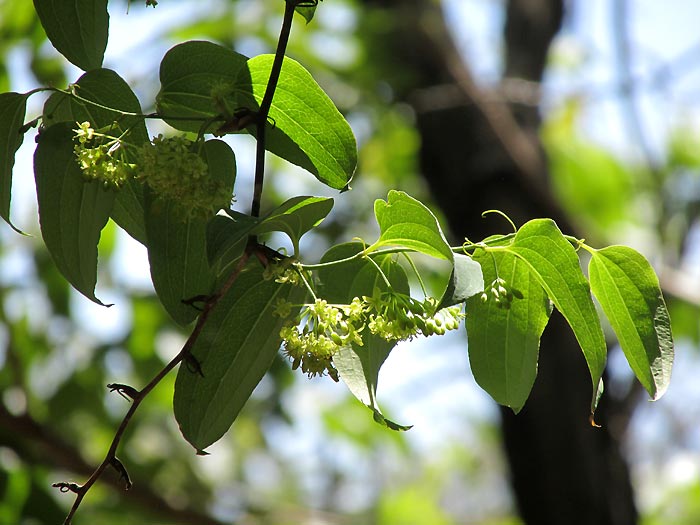Excerpts from Jim Conrad's
Naturalist Newsletter
entry from field notes dated April 16, 2022, taken in disturbed/reforesting borderline cloudforest within 1km of Valle de los Fantasmas, elevation ±2,320m (7600 ft), with limestone bedrock; about 40kms (24 miles), straight-line, ESE of San Luis Potosí, San Luis Potosí state, MÉXICO, (N22.06°, W100.62°)
GREENBRIAR, SMILAX MORANENSIS

Exploring the steep upper slopes of a sinkhole in limestone bedrock, a comfortable looking spot turned up so I lay down for a rest. About 15ft (4.5m) above my head, the above vine with dangling umbles of greenish-white flowers glowed prettily in the midday heat. At a glance I knew it was a member of the genus Smilax. That's because in rural Kentucky I grew up among Smilax species, calling them catbriers, greenbriers and some names that are unprintable because while wandering in the forests my feet constantly were entangling with them, bloodying my ankles with their hard spines.
But surely this was another greenbriar species. The vine hung out of reach over the sinkhole and I didn't want to hurt it by knocking it down with a long stick. In the end, just with features apparent in the above photo, a fairly certain ID was attained with the help of the online Flora del Bajío, the Bajío region being on the southern border of San Luis Potosí state.
The above photo shows the general leaf shape, which was compared with the shapes of leaves of other species occurring in central Mexico, easily found on the Internet. The leaves and stems are not hairy, and bear five major veins. Their bases are rounded or somewhat squared, but not deeply "eared" or wedge shaped. The stems, or peduncles, from which the flower clusters arise are longer than the leaf petiole they are associated with.
These features alone narrow down the possibilities to two fairly similar species. However, one of those species, Smilax jalapensis, generally occurs at elevations below 1500. The other, Smilax moanensis, nearly always appears above 1500m. We're at 2320 meters. Plus, our leaves' shape more matches the latter. Therefore, SMILAX MORANENSIS.
Another reason for confidence in that name is that among the 21 Smilax species documented for Mexico, Smilax moanensis usually is as the most flexible in its habitat requirements, and so exhibits the most extensive geographic and ecological distribution. It occurs from central Mexico south to northern Nicaragua.
People throughout this area call it Zarzaparrilla, which is the common name for all greenbriars. However, often when this name is used, Smilax moanensis is being thought of, largely because of its fame as a powerful medicinal plant. It's valued as an expectorant (loosens up mucus/phlegm in the lungs so it can be coughed out), diuretic (causes peeing out of sodium and water), and for its anti-inflammatory properties (reduces inflammation and often pain). However, the use science is paying attention to these days is the plant's traditional use in treating Type 2 diabetes.
Adriana Romo-Pérez and others in a 2019 publication entitled "Chronic hypoglycemic effect and phytochemical composition of Smilax moranensis roots" reported that "Animal experiments confirmed that the plant extract could control both the glucose and HbA1c levels." HbA1c is one's average blood glucose (sugar) level for the last two to three months.
By the way, the Spanish name for greenbriars, Zarzaparrilla, was corrupted by English speakers into "sarsaparilla," the soft drink made famous in old cowboy movies. The sarsaparilla drink originally was made with a greenbriar extract, from Smilax ornata. Later the sarsaparilla drink came to be made of a blend of birch oil and dried sassafras root bark. You may enjoy reading Wikipedia's Sarsaparilla (soft drink) page.